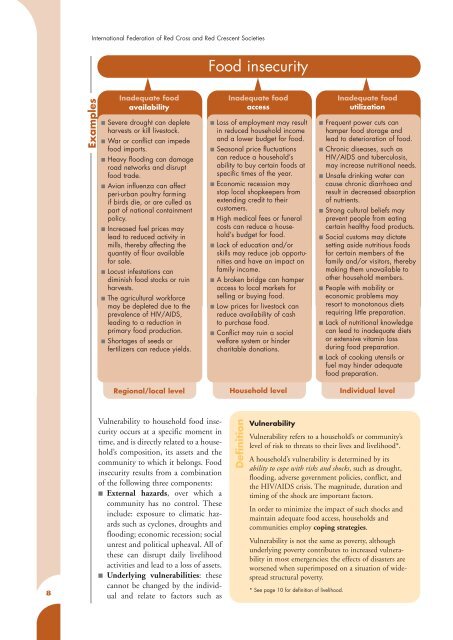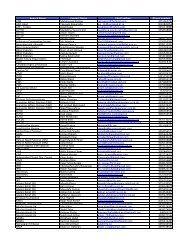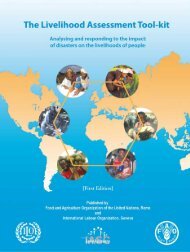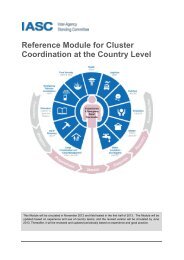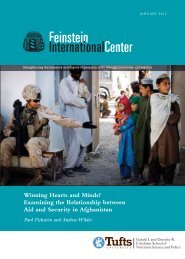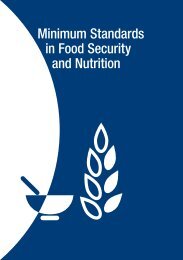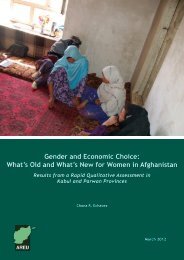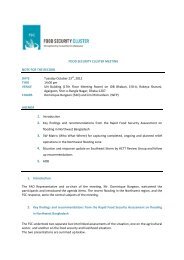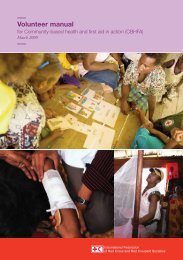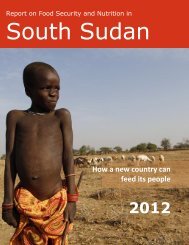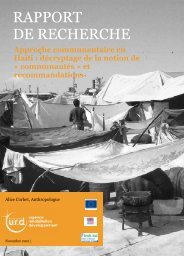Global food security assessment guidelines: A step-by - International ...
Global food security assessment guidelines: A step-by - International ...
Global food security assessment guidelines: A step-by - International ...
Create successful ePaper yourself
Turn your PDF publications into a flip-book with our unique Google optimized e-Paper software.
<strong>International</strong> Federation of Red Cross and Red Crescent SocietiesFood in<strong>security</strong>ExamplesInadequate <strong>food</strong>availability■ Severe drought can depleteharvests or kill livestock.■ War or conflict can impede<strong>food</strong> imports.■ Heavy flooding can damageroad networks and disrupt<strong>food</strong> trade.■ Avian influenza can affectperi-urban poultry farmingif birds die, or are culled aspart of national containmentpolicy.■ Increased fuel prices maylead to reduced activity inmills, there<strong>by</strong> affecting thequantity of flour availablefor sale.■ Locust infestations candiminish <strong>food</strong> stocks or ruinharvests.■ The agricultural workforcemay be depleted due to theprevalence of HIV/AIDS,leading to a reduction inprimary <strong>food</strong> production.■ Shortages of seeds orfertilizers can reduce yields.Inadequate <strong>food</strong>access■ Loss of employment may resultin reduced household incomeand a lower budget for <strong>food</strong>.■ Seasonal price fluctuationscan reduce a household’sability to buy certain <strong>food</strong>s atspecific times of the year.■ Economic recession maystop local shopkeepers fromextending credit to theircustomers.■ High medical fees or funeralcosts can reduce a household’sbudget for <strong>food</strong>.■ Lack of education and/orskills may reduce job opportunitiesand have an impact onfamily income.■ A broken bridge can hamperaccess to local markets forselling or buying <strong>food</strong>.■ Low prices for livestock canreduce availability of cashto purchase <strong>food</strong>.■ Conflict may ruin a socialwelfare system or hindercharitable donations.Inadequate <strong>food</strong>utilization■ Frequent power cuts canhamper <strong>food</strong> storage andlead to deterioration of <strong>food</strong>.■ Chronic diseases, such asHIV/AIDS and tuberculosis,may increase nutritional needs.■ Unsafe drinking water cancause chronic diarrhoea andresult in decreased absorptionof nutrients.■ Strong cultural beliefs mayprevent people from eatingcertain healthy <strong>food</strong> products.■ Social customs may dictatesetting aside nutritious <strong>food</strong>sfor certain members of thefamily and/or visitors, there<strong>by</strong>making them unavailable toother household members.■ People with mobility oreconomic problems mayresort to monotonous dietsrequiring little preparation.■ Lack of nutritional knowledgecan lead to inadequate dietsor extensive vitamin lossduring <strong>food</strong> preparation.■ Lack of cooking utensils orfuel may hinder adequate<strong>food</strong> preparation.Regional/local level Household level Individual level8Vulnerability to household <strong>food</strong> in<strong>security</strong>occurs at a specific moment intime, and is directly related to a household’scomposition, its assets and thecommunity to which it belongs. Foodin<strong>security</strong> results from a combinationof the following three components:■ External hazards, over which acommunity has no control. Theseinclude: exposure to climatic hazardssuch as cyclones, droughts andflooding; economic recession; socialunrest and political upheaval. All ofthese can disrupt daily livelihoodactivities and lead to a loss of assets.■ Underlying vulnerabilities: thesecannot be changed <strong>by</strong> the individualand relate to factors such asDefinitionVulnerabilityVulnerability refers to a household’s or community’slevel of risk to threats to their lives and livelihood*.A household’s vulnerability is determined <strong>by</strong> itsability to cope with risks and shocks, such as drought,flooding, adverse government policies, conflict, andthe HIV/AIDS crisis. The magnitude, duration andtiming of the shock are important factors.In order to minimize the impact of such shocks andmaintain adequate <strong>food</strong> access, households andcommunities employ coping strategies.Vulnerability is not the same as poverty, althoughunderlying poverty contributes to increased vulnerabilityin most emergencies; the effects of disasters areworsened when superimposed on a situation of widespreadstructural poverty.* See page 10 for definition of livelihood.


